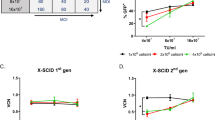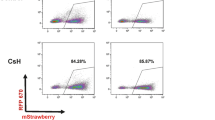Abstract
Nonhuman primates are increasingly being used as models for pre-clinical assessment of retrovirus vector expression and function following stem and progenitor cell transduction. We compared the relative susceptibility of CD34+ marrow progenitors from four nonhuman primate species and humans to transduction with amphotropic pseudotyped retrovirus vectors containing the Neo gene. The rate of functional gene transfer was measured by colony formation under G418 selection. Marrow progenitors from pigtail macaques (Macaca nemestrina) were transduced at about twice the rate (19.1 ± 4.3%) as those from rhesus (11.2 ± 3.7%) and cynomolgus (7.6 ± 1.9%) macaques, baboons (7.8 ± 1.8%), and humans (9.6 ± 1.7%). Semiquantitative RT/PCR analysis suggests this difference may be due to elevated expression of the amphotropic receptor Pit2 in pigtailed macaque CD34+ cells. Further, transduction rates increased an average 1.6 ± 0.4-fold when the culture temperature was lowered to 33°C, and 2.1 ± 0.3-fold when the culture dishes were coated with the fibronectin fragment CH-296. The data presented here point to important differences among nonhuman primate models as well as transduction culture conditions, and suggest that pigtailed macaques may be particularly useful for assessing expression and function of therapeutic retrovirus vectors.
This is a preview of subscription content, access via your institution
Access options
Subscribe to this journal
Receive 12 print issues and online access
$259.00 per year
only $21.58 per issue
Buy this article
- Purchase on Springer Link
- Instant access to full article PDF
Prices may be subject to local taxes which are calculated during checkout






Similar content being viewed by others
References
Miller AD . Human gene therapy comes of age Nature 1992 357: 455–460
Lemishka IR, Raulet DH, Mulligan RC . Developmental potential and dynamic behavior of hematopoietic stem cells Cell 1986 45: 917–927
Bodine DM, Karlsson S, Nienhuis AW . Combination of interleukin 3 and 6 preserves stem cell function in culture and enhances retrovirus-mediated gene transfer into hematopoietic stem cells Proc Natl Acad Sci USA 1989 86: 8897–8901
Chillita P-M, Kohn DB . Lack of expression from a retroviral vector after transduction of murine hematopoietic stem cells is associated with methylation in vivo Proc Natl Acad Sci USA 1994 91: 2567–2571
Lothrop CP et al. Expression of a foreign gene in cats reconstituted with retroviral vector infected autologous bone marrow Blood 1991 78: 237–245
Schuening FG et al. Improved retroviral transfer of genes into canine hematopoietic progenitor cells kept in long-term marrow culture Blood 1989 74: 152–155
Emery DW et al. Expression of an allogeneic MHC DRB transgene, through retroviral transduction of bone marrow, induces specific reduction of alloreactivity Transplantation 1997 64: 1414–1423
Van Beusechem VW, Valerio D . Gene transfer into hematopoietic stem cells of nonhuman primates Hum Gene Ther 1996 7: 1649–1668
Brenner MK et al. Gene marking to determine whether autologous marrow infusion restores long-term haemopoiesis in cancer patients Lancet 1993 342: 1134–1137
Dunbar CE et al. Retrovirally marked CD34-enriched peripheral blood and bone marrow cells contribute to long-term engraftment after autologous transplantation Blood 1995 85: 3048–3057
Kiem H-P et al. Gene transfer into marrow repopulating cells: comparison between amphotropic and gibbon ape leukemia virus pseudotyped retroviral vectors in a competitive repopulation assay in baboons Blood 1997 90: 4638–4645
Kiem H-P et al. Improved gene transfer into baboon marrow repopulating cells using recombinant human fibronectin fragment CH-296 in combination with interleukin-6, stem cell factor, Flt-3 ligand, and megakaryocyte growth and development factor Blood 1998 92: 1878–1886
Dunbar CE et al. Improved retroviral gene transfer into murine and rhesus peripheral blood or bone marrow repopulating cells primed in vivo with stem cell factor and granulocyte colony-stimulating factor Proc Natl Acad Sci USA 1996 93: 11871–11876
Bodine DM et al. Improved amphotropic retrovirus-mediated gene transfer into hematopoietic stem cells Ann NY Acad Sci 1998 850: 139–150
Banerjee PT et al. Retrovirus mediated transfer and expression of swine MHC class II genes in CD34+ monkey stem cells Transplant Proc 1996 28: 747–748
Anderson DM et al. HIV in non-human primates: the Macaca nemestrina model Virus Res 1994 32: 269–282
Bosch ML et al. Infection of Macaca nemestrina neonates with HIV-1 via different routes of inoculation AIDS 1997 11: 1555–1563
Looney DJ et al. A minimally replicative HIV-2 live virus vaccine protects M. nemestrina from disease after HIV-2(287) challenge Virology 1998 242: 150–160
Papayannopoulou T et al. In vivo effects of Flt3/Flk2 ligand on mobilization of hematopoietic progenitors in primates and potent synergistic enhancement with granulocyte colony-stimulating factor Blood 1997 90: 620–629
Miller AD . Cell-surface receptors for retroviruses and implications for gene therapy Proc Natl Acad Sci USA 1996 93: 11407–11413
Orlic D et al. The level of mRNA encoding the amphotropic retrovirus receptor in mouse and human hematopoietic stem cells is low and correlates with the efficiency of retrovirus transduction Proc Natl Acad Sci USA 1996 93: 11097–11102
Kurre P et al. Efficient transduction by an amphotropic retrovirus vector is dependent on high-level expression of the cell surface virus receptor J Virol 1999 73: 495–500
Moritz T, Patel VP, Williams DA . Bone marrow extracellular matrix molecules improve gene transfer into human hematopoietic cells via retroviral vectors J Clin Invest 1994 93: 1451–1457
Hanenberg H et al. Colocalization of retrovirus and target cells on specific fibronectin fragments increases genetic transduction of mammalian cells Nature Med 1996 2: 876–882
Miller AD, Rosman GJ . Improved retroviral vectors for gene transfer and expression BioTechniques 1989 7: 980–990
Miller D, Buttimore C . Redesign of retrovirus packaging cell lines to avoid recombination leading to helper virus production Mol Cell Biol 1986 6: 2895–2902
Nolta JA, Smogorzewska EM, Kohn DB . Analysis of optimal conditions for retroviral-mediated transduction of primitive human hematopoietic cells Blood 1995 86: 101–110
Andrews RG et al. CD34+ marrow cells, devoid of T and B lymphocytes, reconstitute stable lymphopoiesis and myelopoiesis in lethally irradiated allogeneic baboons Blood 1992 80: 1693–1701
Terstappen LW et al. Sequential generations of hematopoietic colonies derived from single nonlineage-committed CD34+CD38− progenitor cells Blood 1991 77: 1218–1227
Bauer TR, Miller AD, Hickstein DD . Improved transfer of the leukocyte integrin CD18 subunit into hematopoietic cell lines by using retroviral vectors having a gibbon age leukemia virus envelope Blood 1995 86: 2379–2387
Alonso S, Minty A, Bourlet Y, Buckingham M . Comparison of three actin-coding sequences in the mouse; evolutionary relationship between the actin genes of warm-blooded vertebrates J Mol Evol 1986 23: 11–22
Kotani H et al. Improved methods of retroviral vector transduction and production for gene therapy Hum Gene Ther 1994 5: 19–28
Dexter TM, Allen TD, Lajtha LG . Conditions controlling the proliferation of haemopoietic stem cells in vitro J Cell Physiol 1977 91: 335–344
Schuening FG, Storb R, Meyer J, Goehle S . Long-term culture of canine bone marrow cells Exp Hematol 1989 17: 411–417
Emery DW, Sachs DH, LeGuern C . Culture and characterization of hematopoietic progenitor cells from miniature swine Exp Hematol 1996 24: 927–935
Eaves AC, Cashman JD, Gaboury LA, Eaves CJ . Clinical significance of long-term cultures of myeloid blood cells CRC Crit Rev Oncol Hematol 1987 7: 125–138
Dao MA, Shah AJ, Crooks GM, Nolta JA . Engraftment and retroviral marking of CD34+ and CD34+CD38− human hematopoietic progenitors assessed in immune-deficient mice Blood 1998 91: 1243–1255
Du X, Williams DA . Interleukin-11: review of molecular, cell biology, and clinical use Blood 1997 89: 3897–3908
Dao MA, Hashino K, Kato I, Nolta JA . Adhesion to fibronectin maintains regenerative capacity during ex vivo culture and transduction of human hematopoietic stem and progenitor cells Blood 1998 92: 4612–4621
Abkowitz JL, Catlin SN, Guttorp P . Strategies for hematopoietic stem cell gene therapy: insights from computer simulation studies Blood 1997 89: 3192–3198
Firpo PP, Axberg I, Scheibel M, Clark EA . Macaque CD4+ T-cell subsets: influence of activation on infection by simian immunodeficiency viruses AIDS Res Hum Retroviruses 1992 8: 357–365
Kiem H-P et al. Long-term persistence of canine hematopoietic cells genetically marked by retrovirus vectors Hum Gene Ther 1995 7: 89–96
Yu J, Soma T, Hanazono Y, Dunbar CE . Abrogation of TGF-β activity during retroviral transduction improves murine hematopoietic progenitor transduction and repopulating cell gene transfer efficiency Gene Therapy 1998 5: 1265–1271
Kavanaugh MP et al. Cell-surface receptors for gibbon ape leukemia virus and amphotropic murine leukemia retrovirus are inducible sodium-dependent phosphate symporters Proc Natl Acad Sci USA 1994 91: 7071–7075
Bienzle D et al. Gene transfer into hematopoietic stem cells: long-term maintenance of in vitro activated progenitors without marrow ablation Proc Natl Acad Sci USA 1994 91: 350–354
Miller DG, Adam MA, Miller AD . Gene transfer by retrovirus vectors only occurs in cells that are actively replicating at the time of infection Mol Cell Biol 1990 10: 4239–4242
Armentano D et al. Effects of internal viral sequences on the utility of retroviral vectors J Virol 1987 61: 1647–1650
Markowitz D, Goff S, Bank A . A safe packaging line for gene transfer: separating viral genes on two different plasmids J Virol 1988 62: 1120–1124
Moore KA et al. Stromal support enhances cell-free retroviral vector transduction of human bone marrow long-term culture-initiating cells Blood 1992 79: 1393–1399
Bodine DM et al. Development of a high-titer retrovirus producer cell line capable of gene transfer into rhesus monkey hematopoietic stem cells Proc Natl Acad Sci USA 1990 87: 3738–3742
Kaushansky K et al. Structure–function relationships of interleukin-3. Analysis based on the function and binding characteristics of a series of interspecies chimera of gibbon and murine interleukin-3 J Clin Invest 1992 90: 1879–1888
Eaves CJ, Eaves AC . Erythropoietin (Ep) dose–response curves for three classes of erythroid progenitors in normal human marrow and in patients with polycythemia vera Blood 1978 52: 1196–1210
Nolta JA et al. Transduction of pluripotent human hematopoietic stem cells demonstrated by clonal analysis after engraftment in immune-deficient mice Proc Natl Acad Sci USA 1996 93: 2414–2419
Chirgwin JM, Przybyla AE, MacDonald RJ, Rutter WJ . Isolation of biologically active ribonucleic acid from sources enriched in ribonuclease Biochemistry 1979 18: 5294–5299
Acknowledgements
We would like to thank A Dusty Miller for the retrovirus vector LN and packaging line PA317, Kateri A Moore for the N2/AM12 producer clone, and Kenneth Kaushansky for the gibbon IL-3 producing cell line BHKIL-3 and recombinant human Tpo. We would like to acknowledge the following companies for providing biological materials: Amgen Corp. for recombinant human SCF; Sandoz Pharmaceuticals Corp. for recombinant human IL-6; Immunex Corp. for recombinant human Flt3-L; Genetics Institute for recombinant human IL-11; and Takara Shuzo Co., Ltd, for the recombinant fibronectin fragment CH-296. We also gratefully thank XiaoChun Wang, Arron Winkler and Betty Mastropaolo for technical support. This work was made possible in part through the tissue distribution program of the University of Washington Regional Primate Center (NIH grant RR00166). This work was supported by grants and contracts HL 53750, AI35191, and HL 54881 from the National Institutes of Health.
Author information
Authors and Affiliations
Rights and permissions
About this article
Cite this article
Emery, D., Andrews, R. & Papayannopoulou, T. Differences among nonhuman primates in susceptibility to bone marrow progenitor transduction with retrovirus vectors. Gene Ther 7, 359–367 (2000). https://doi.org/10.1038/sj.gt.3301107
Received:
Accepted:
Published:
Issue Date:
DOI: https://doi.org/10.1038/sj.gt.3301107
Keywords
This article is cited by
-
Hematopoietic Stem Cell Gene Therapy
International Journal of Hematology (2002)



